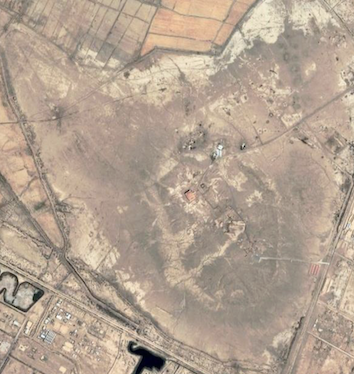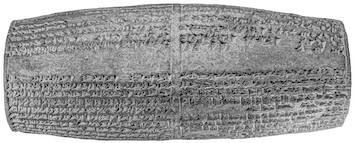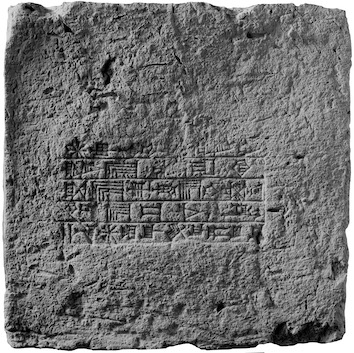Temples, Shrines, and Ziggurat of Ur

Ur (modern Tell el-Muqayyar) is perhaps one of the best-known Sumerian cities, in part due to the fact that the Old Testament book of Genesis records that Abraham lived there and in part due to the fact that the lowest stage of its ziggurat has been restored and is now a UNESCO World Heritage Site. This large and important southern Mesopotamian city is situated south of the Euphrates River, ca. 16 km from the modern city of Nasiriyah. Ur is the most important southern Mesopotamian cult center of the moon-god (Nanna/Sîn). Numerous cuneiform sources — including several first-millennium-BC lists of temples and ziggurats and some Neo-Assyrian and Neo-Babylonian royal inscriptions — record the Sumerian ceremonial names of many of its religious structures, most of which are listed below. Its most important religious buildings were its principal temple Ekišnugal and its ziggurat Elugalgalgasisa, both of which were dedicated to Sîn (Nanna). During the Neo-Babylonian Empire (625–539 BC, Egipar, the residence of the en-priestess of the god Nanna/Sîn, and Enunmah, the bīt hilṣi of the goddess Ningal, were also important religious structures at Ur.
Alphabetical list of temples at Ur

Satellite image of Ur (modern Tell el-Muqayyar), with its partially reconstructed ziggurat.
- Baraennun: a shrine
- Barakisikila: seat of the god Anu
- Barašadišša: seat of the god Lugalerra
- Dubaragalmah: cultic location
- Eaʾaggasumu: temple of the god Ninšubur
- Eaʾanda: a sanctuary, presumably of the goddess Ningal
- Eadgigi: seat of the god Nusku
- Eankikuga: socle of the deity Kusu
- Eanšar: a shrine
- E.AŠ.AN.AMAR: seat of the god Enlil
- Edimana: sanctuary of the god Sîn
- E.DUB.galekura: seat of the deity Ninimma
- Edublamah: court of judgement dedicated to the god Nanna/Sîn
- Eʾennungaga: a shrine
- Eʾerimhašhaš: temple of the god Nergal
- Eʾešbanda: seat of the deity Šuzianna
- Eʾešbarsisa: sanctuary of the god Enki
- Eʾešbarzida: temple of the deity Ninsianna
- Eʾeškite(n): sanctuary of the god Nanna/Sîn
- Eʾešmedagala: temple of the god Dagān
- Egabur(a): temple of the goddess Ningublag
- E.GA.DI: sanctuary of the goddess Ningal
- Egalmah: temple of the goddess Gula as Ninisinna
- (E)ganunmah: treasury of the god Nanna/Sîn
- Egarku: designation of the sanctuary of the goddess Ningal in Egipar
- Egešbuba.KIB-gunû-ma: a sanctuary
- Egeštumahšudu: sanctuary of the god Ea
- Egeštušudu: temple of the god Enki
- Egipar: residence of the en-priestess of the god Nanna/Sîn
- Egipar: residence of the en-priestess of the goddess Ningublag
- Eguba: a shrine
- Ehili: temple of the god Utu
- Ehursag: temple of the deified king Šulgi
- Ehursagsiga: seat of the god Meslamtaea
- Eigarasu: temple of the god Dumuzi
- Eirara: a temple
- Eidlurugukalama: shrine of the goddess Ningal in Egipar
- Eituda: sanctuary of the goddess Nanāya
- Ekišnugal: temple of the god Nanna/Sîn
- Ekitušmah: name (or epithet) of the cella of the god Nanna/Sîn
- Ekituššaten: temple of the god Zababa
- Ekuga: temple of the god Nergal
- Elugalgalgasisa: ziggurat the god Nanna/Sîn
- Emagur: epithet or part of the temple of the god Nanna/Sîn
- Emah: temple of the goddess Ninsun
- Emelamsulimguru: temple of of the god Meslamtaea
- Emudkurkura: shrine, perhaps the cella of the god Sîn
- Emurianabak: sanctuary of the god Nanna/Sîn
- Enamnuna: sanctuary of the god Nanna/Sîn
- Eniggina: temple of the god Ningišzida
- Eninbišetum: temple of the goddess Ninlil
- Eninbitum: temple of the god Ninšubur
- Enunmah: bīt hilṣi of the goddess Ningal
- Esagdil: a shrine
- Ešaduga: a seat
- Ešbur: sanctuary of the goddess Inanna of Eridu
- Ešgalmah: part of (E)ganunmah
- Ešugandudu: ziggurat at Ur
- Ešuhubbi[...]: a sanctuary
- Ešutumku: temple of the goddess Inanna/Ištar
- Ešutumku: storehouse of the god Sîn
- Etemenniguru: ziggurat terrace of the god Nanna/Sîn
- Etemenniʾila: a sanctuary
- Etilmun(a): temple of the goddess Inanna-Ištar
- Eušumgalana: socle of the goddess Ninkasi
- E[...]gukuga: seat of the god Ennugi
- E[...]karkar: temple of the god Enlil
- Giparku: sanctuary of the goddess Ningal
- Karzagina: sacred quay
- Kiduga: a shrine
- Kidurgar: a shrine
- Kirimah: sacred garden planted for the god Anu

YBC 2182, the En-nigaldi-Nanna Cylinder, which celebrates the consecration of the king's daughter En-nigaldi-Nanna as a priestess at Ur and the rebuilding of her residence in the Egipar. Courtesy of the Yale Babylonian Collection; photography by Klaus Wagensonner.

BM 114288, a brick discovered at Ur with an inscription stating that the king rebuilt Enunmaḫ, a building of the goddess Ningal inside the Ekišnugal temple complex. © Trustees of the British Museum.
In addition, there are at least five unnamed temples mentioned in cuneiform sources. These are dedicated to the deities Anunnītum, Nimintab, Ninegal, Ninšagepada, and Ninšar.
Jamie Novotny & Niclas Dannehl
Jamie Novotny & Niclas Dannehl, 'Temples, Shrines, and Ziggurat of Ur', Babylonian Temples and Monumental Architecture online (BTMAo), The BTMAo Project, a sub-project of MOCCI, [http://oracc.org/btmao/Ur/]